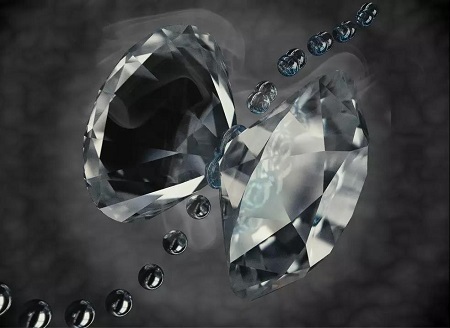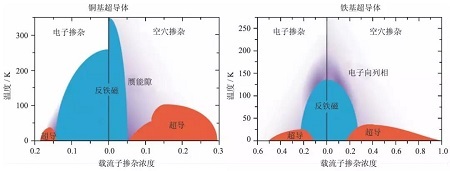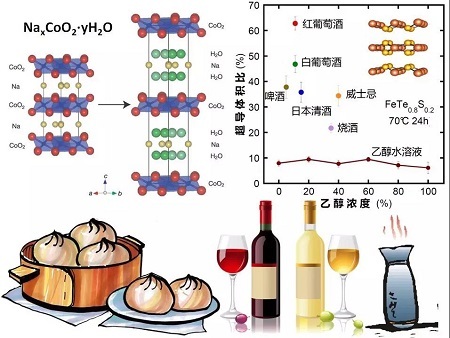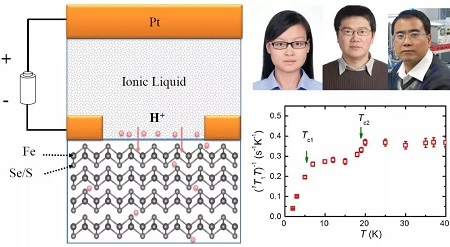This article is authorized by the Zhishe Academic Circle (zhishexueshuquan)
ã€Summary】
Recently, Prof. Yu Weiqiang from Renmin University of China and Prof. Yu Pu from Tsinghua University (Quantum Design Product User) research team cooperated with domestic counterparts to realize the hydrogenation of iron-based superconducting materials by using ionic liquid grid technology. Superconductivity under volatile electron doping. For the first time, the superconducting transition temperature of FeS materials was increased from 5K to 18K, which broke the long-standing predicament of iron-based superconducting nuclear magnetic resonance experiments and opened up a new way of exploring superconductivity. The related results were published in Science Bulletin, published on January 1, 2018, entitled "Protonation induced high-Tc phases in iron-based superconductors evidenced by NMR and magnetization measurements" (Science Bulletin 63, 11-16 (2018)) [1].
Why can hydrogenation achieve superconductivity?
What does the emergence of this research method mean?
Luo Huizhen | Associate Research Fellow, Institute of Physics, Chinese Academy of Sciences
[1, hydrogen and superconducting knot family]
Hydrogen, the lightest element in nature, contains only one proton and one electron. Hydrogen is one of the most important elements in nature. Because hydrogen and oxygen make up water, it gives birth to all living things. Hydrogen is also the most important starting point for scientific research. The success of quantum mechanics started from hydrogen atoms.
Superconductivity is a magical phenomenon of macroscopic quantum condensation. Under certain temperatures, the resistance of some materials will drop to zero and complete diamagnetism will occur. The essence of superconductivity comes from the pairing of electrons in the material. The so-called "men and women match, work is not tired", the paired electrons can achieve unobstructed conduction. However, for most superconducting materials, it is necessary to drop to a sufficiently low temperature to superconduct, called the superconducting critical temperature. How to improve the superconducting critical temperature and how to understand the superconducting microscopic mechanism has become the core goal of superconductivity research [2].
For a long time, scientists have persistently believed that hydrogen can be expected to achieve superconductivity at room temperature, but the conditions are extremely demanding - it needs to be metalized under ultra-high pressure, which is about equal to the internal pressure of the earth, in millions Above atmospheric pressure! There is only one way to achieve such a high static pressure, that is, risking an explosion, with two diamonds against the top. Although some scientists claimed to have found metal hydrogen, they accidentally lost their diamonds during the measurement of their superconductivity [3]. German scientists have also found 203K superconductivity in hydrogen sulfides, but need to be at 2 million atmospheres [4]! Such a huge pressure, it is almost impossible to talk about the application prospects.
The inextricable link between hydrogen and superconductivity has always lingered in the minds of scientists.

Figure 1. Metal hydrogen under ultra-high pressure [3]
[2, high temperature superconductivity under Chinese cooking]
The exploration of superconducting materials has been dubbed by scientists as “Chinese-style cookingâ€â€”mixing several elements of a single element or compound through a certain ratio, and obtaining a superconductor after high-temperature sintering. Just like the eight major cuisines of Lu, Sichuan, Guangdong, Jiangsu, Zhejiang, Anhui, Hunan, and Anhui, superconducting materials also have different systems, including metal elements, alloys, oxides, sulfides, and organic substances, due to different raw materials and methods. Various forms of materials. These "dish dishes" have different tastes, and their physical properties vary widely. The superconducting critical temperature also has its own merits.
In the 1980s, a new class of copper oxide superconductors was discovered because they broke through the 40K limit predicted by the theory at the time and were called "high temperature superconductors" [2] [5]. After more than 30 years, many copper oxide high-temperature superconductors have been discovered, which greatly promoted the historical process of superconductivity research. In 2008, a new class of high-temperature superconductors was discovered again. They are the "iron-based superconductor" family, mainly composed of iron arsenide, iron selenide and iron sulfide. The critical temperature of the block can reach 55K, and the criticality of the monoatomic layer is critical. The temperature has broken through 65K and is likely to move higher [6]. High-temperature superconductivity looks like a general physical phenomenon, but people still do not know much.
Both types of high-temperature superconductors have a common feature, which is the need for superb cooking skills. It's not just a simple mix of raw materials, it also requires precise control of the temperature (temperature) and process. The most difficult thing is that you need to add certain spices such as sugar, salt, vinegar, soy sauce, monosodium glutamate, pepper, etc., and adjust the taste to the perfect superconductivity. This seasoning is chemical doping. Through element replacement or atomic defects, artificially adding a current-carrying carrier, electrons or holes, superconducting occurs at a large number of pairs at low temperatures. The precursor of the copper oxide high-temperature superconductor itself is an antiferromagnetic insulator, but the doping can adjust it to the state of the metal conductor, and then cool down to become a superconductor. If you stir up a good dish, the superconducting critical temperature can reach 135K under normal pressure, and there is a certain distance from room temperature 300K. However, it has more "taste" than elemental metal (such as metal aluminum is 1.4K). , metal mercury is 4.2K, metal bismuth is 9K) [7].
The seasoning has increased, and there are also troubles. It tastes very delicious and delicious, but it is difficult to figure out which seasoning has played a key role, or what kind of mechanism is under the compounding. Because the carrier doping effect is extremely complex, such as changing the crystal structure, magnetic properties, electrical properties, thermodynamic properties, etc., many phenomena have surpassed our existing theoretical framework system. The microscopic mechanism of high temperature superconductivity has been a scientific mystery for many years and has become the shining pearl in the crown of condensed matter physics.

Figure 2. Doping phase diagram of copper-based and iron-based high-temperature superconductors [2]
[3. Superconductors for drinking water and drinking alcohol]
While other scientists were sweating and busy looking for superconductors, some people also swayed their swords and played with steamed buns superconductors and alcoholic superconductors.
For example, a type of cobalt oxide itself is difficult to superconduct, but after the experience in the steamer, after the water is incorporated, it is superconducted [8]!
Another example is that the superconducting properties of a class of iron sulfide materials are often very poor. After soaking it in various wines, it is superconducting! And this guy is also elegant in wine, most like a winery in France. A certain brand of red wine in the year, drinking alcohol instead of doing it [9]!
Whether it is water or wine, the mystery hidden inside is perhaps the legendary hydrogen?

Figure 3. Drinking superconductor NaxCoO2 and drinking superconductor FeTe0.8S0.2[8][9]
[4, superconducting in the bath crab]
Saying that drinking water and drinking can be superconducting. If you take some materials to wash your bath, can you superconduct it? Just like a hairy crab in a lake, washing and washing a label, it is a well-known multiplier. secret.
Washing the iron-based superconducting material, what will happen?
Chinese scientists really did this! To be exact, it was a hot spring for iron sulfide. The spring is not unusual. It is a pile of "ionic liquids" filled with a variety of charged ions. Use platinum wire as the anode, the material to be bathed as the cathode, and the gate voltage. Thus, the hydrogen ions in the ionic liquid, under the action of the electrodes, rush to the surface of the material and even penetrate into the interior. Hydrogen ions (protons) are positively charged. After being injected into the material, a large amount of electrons are poured into the material, so that the material is actually doped with more electrons.
The electron doping makes the FeS which is only 5K superconducting become 18K superconducting, while the FeSe0.97S0.03 has 42.5K superconducting, even the BaFe2As2 matrix material which is completely non-superconducting, and 20K superconducting Originally, chemical doping, which requires element replacement, is required to inject hydrogen ions by "bathing", and superconducting after doping is also achieved, and the crystal structure of the material is not changed.
It’s really "hydrogen I will superconduct"!
[5, there is a mysterious above the hydrogen cloud]
Using gate voltage to change the number/concentration of carriers in a material is not a new invention. In fact, this is the set of semiconductor materials. In the semiconductor PN junction, the LED optical component can be realized by controlling the electron-hole pair annihilation by controlling the current through or without a bias to make a logic circuit element [10]. It must be noted that the carrier concentration in the superconductor is quite different from that of the semiconductor, and the former is 7-8 orders of magnitude larger. There is no doubt that the higher the carrier concentration, the more particles that participate in conduction and the better the conductivity. The method of commanding a death squad does not necessarily apply to a thousand troops.
The concentration of electrons on the surface of the superconductor can also be adjusted by ionic liquid or ionic solid gate voltage regulation. Chinese scientists have discovered in the past few years that the original critical temperature of FeSe thin layer material is only 9K, and it is rapidly increased to 46K after the ion gate adjusts the carrier [11]. This technique relies on covering a layer of ions on the surface of the material, and by accumulating ions on the surface by a bias voltage, the charge in the body is redistributed, causing a doping effect. The resulting effect scale is limited, the removal of the bias voltage will lose the effect, and the regulation of the doping concentration is limited, which is the shortcoming of the method.
If the ions are directly injected into the material, Professor Yu Pu of Tsinghua University thinks of the electrochemical method. Simply use the material as the electrode itself, apply a voltage to the ionic liquid, and the ions will be injected or removed from the material to achieve electron or hole doping. After groping, they first achieved electrochemical ion implantation in the oxide material. As long as the temperature and voltage are controlled, the physical properties can be adjusted without damaging the material itself, and the process is reversible!
Professor Yu Weiqiang from Renmin University of China is mainly engaged in nuclear magnetic resonance research. The dream of many years has been to achieve hydrogen injection of high temperature superconductors. Because NMR has great selectivity for isotopes, the elements contained in high-temperature superconductors are either not suitable for experiments, or the isotope required is extremely expensive, and the most powerful hydrogen ion injected into the NMR signal is most suitable. Professor Yu Pu's method and Professor Yu Weiqiang's idea hit it off, so "two in cooperation" smoothly put hydrogen ions into the superconductor.

Figure 4. Principles, results and main researchers of hydrogen-injected iron-based superconducting experiments: Cui Wei, Yu Pu, Yu Weiqiang, etc. (Provided by Yu Weiqiang)
The magical scene has been unveiled, and the performance of iron-based superconductors has been greatly improved! The same "hydrogen injection superconducting" is also reversible, and almost does not change the material structure, while withdrawing from the "bath water" still retains superconductivity . This means that the new superconducting control method can avoid the trouble caused by the previous chemical doping, and provides a continuously controllable clean sample not only for nuclear magnetic resonance but also for other superconducting detection methods. Both superconducting materials and superconducting mechanisms will benefit from this!
At present, they are working with domestic partners to try to achieve hydrogen injection superconductivity in more materials, and will eventually open up a new road on the peak of climbing superconducting research!
[Thank you]
I would like to thank Professor Yu Weiqiang from Renmin University of China, Professor Yu Pu from Tsinghua University, and Zou Wenjuan from Science Bulletin for editing and helping.
ã€references】
[1]. Y. Cuiet al., Science Bulletin 63, 11-16 (2018)
[2]. Luo Huizhen, Zhou Xingjiang, Magical Superconductivity, Modern Physics, 24(02), 30-39 (2012).
[3]. RP Dias, IF Silvera, Science 355 (6326), 715-718 (2017).
[4]. AP Drozdov et al., Nature 525, 73-76 (2015).
[5]. JG Bednorz and KA Müller, Z. Phys. B. 64, 189 (1986).
[6]. Luo Huizhen, Past and Present of Iron-based Superconductivity, Physics, 43(07), 430-438(2014).
[7]. A. Schilling et al., Nature 363, 56-58 (1993).
[8]. K. Takada et al., Nature 422, 53-55 (2003).
[9] K. Deguchi et al., Supercond. Sci. Technol. 24, 055008 (2011).
[10]. Huang Kun, Xie Xide, Semiconductor Physics, Science Press, 2012.
[11]. B. Lei et al., Phys. Rev. Lett. 116, 077002 (2016).
[12]. N. Lu et al., Nature 546, 124–128 (2017).
Pastry And Vegetable Processing Machines
With an experience of over 30 years, Helper has designed and manufactured full series of pasta and vegetable processing machines, like bakery industrial dough mixer, automatic fresh and cooked noodle production line, vegetable cutting machine, slicer and dicer, automatic dumpling machine/dumpling machines, sesame mill, pancake forming machine etc. A pasta branch company was estblished with the development the business, owning a group of talented technical people, skilled production workers, and a professional sales and after sales service team. Many famous companies such as Dali Group, Panpan Group, Wanchai Ferry, Sinian Group, and so on have chose Helper as their strategic supplier and partner.
Pastry Processing Machines,Food Packaging Machines,Vegetable Processing Machines,Noodle Production Line,Dumpling Machines
Helper Machinery Group Co., Ltd. , https://www.helperfoodmachiney.com